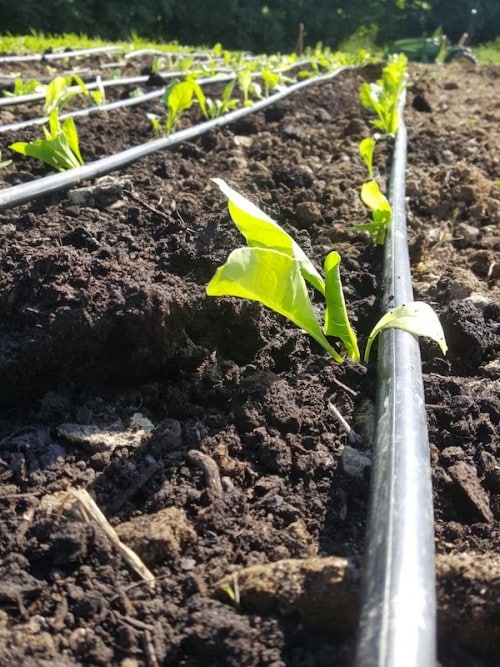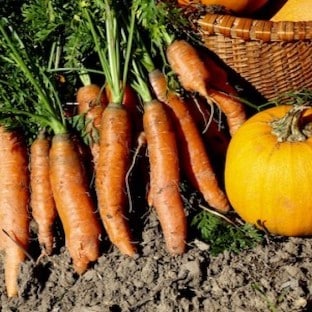
What is succession planting?
Succession planting means that two or more crops are grown in succession in the same space. After one crop is harvested, another is planted in its place. Succession planting means no ground is fallow during the growing season and every inch of space is productive. A successful succession planting plan can be as basic or as intricate as you need it to be, and here at the farm, Tim is constantly working to maximize our yields via a delicate balance of harvesting and planting based on which crops prefer to grow during which time of the year.
How a succession planting plan works
The basic building block of a good succession planting plan is the seasonality of different crops. Some vegetables, like lettuce, spinach, peas, and radish, prefer the cooler weather of spring and fall. While others, such as tomatoes, basil, peppers, and squash, grow best in the heat of summer. A succession planting plan takes those growing preferences and weaves them together to form a matrix of productive plants from early spring through early winter.

Here at the farm, cool-weather crops are planted in the very early spring, and after they're harvested, a heat-loving selection is planted in their place. For example, when the peas are pulled in late June or early July, they're replaced with a planting of cucumbers. Or, after our spring greens are cut and sold at market, the empty beds are then planted with zucchini or green beans.
We're constantly settling new plants into our growing beds all season long. Not only does this practice maximize our production, it also limits our losses if a disease or pest strikes an earlier planting. Succession planting can be an insurance plan of sorts against crop losses.
The importance of diversity in succession planting
When combining crops in a succession planting plan, the possibilities are nearly endless. However, it's important to mix up plant families when succession planting. If you harvest a root crop and then plant another root crop in the same space, soil nutrient depletion may be the result. Members of the same plant family can also share similar disease and pest susceptibilities, so when devising a succession plan, it's important to diversify each generation of crops you plant. For example, follow a spring root crop with a summer vine crop or a fruiting plant, such as a tomato or pepper, rather than planting more roots like beets or turnips in that same space. Diversity is a big part of a successful succession planting plan.

Fall succession planting
Following a spring cool-season crop with a heat-loving one isn't the only way to succession plant. Here at the farm, we also do a lot of succession planting that involves fall crops. This means that just because July 4th has come and gone, doesn't mean the planting season is over. Quite the opposite, in fact. Because we want to have fresh kale, collards, broccoli, cabbage, and other cool-season veggies available to our customers in the autumn and early winter, we start a new round of planting in mid to late July. This later planting yields an incredible autumn harvest because once the cooler temperatures of fall arrive, these late plantings grow like crazy. For some of these cool-season crops we have a better harvest when planting late in the season than we do when planting in early spring.
Depending on how long it takes each crop to mature, a succession planting plan can even include a triple planting. If you choose three fast-maturing crops, it's possible to grow three veggies in the same space. Radish, for example, mature in just 30 days, so if quick-growing baby beets or carrots are planted soon after the radish are harvested, there will be enough time to plant a fall lettuce or kale crop, too. Succession planting opens up so many possibilities and can really increase your yield.

Caring for the soil when succession planting
When succession planting in such an intense way, it's extremely important to consider the health of the soil as well. When intensely farmed in this way, soils can become depleted of nutrients and it's important to replenish what's used by plants as the season progresses. Organic farms like ours care for the soil without using synthetic chemical fertilizers, and we take great measures to ensure our soils remain healthy and nutrient-dense. To do this, we add compost to the ground in between each and every succession crop. Home gardeners should do the same. Not only does an addition of several inches of compost help replenish nutrients, it also introduces beneficial soil micro-organisms that help our plants acquire those nutrients and fight off pests and diseases. Healthy soil means healthy plants and a productive farm or garden.

We hope you enjoyed this little glimpse into how we use a succession planting plan to supply our customers and ourselves with a broad diversity of fresh, organic produce all season long.
For more information on some of our favorite farm crops, please check out these articles:
From, The Cherry Valley Organics Family

